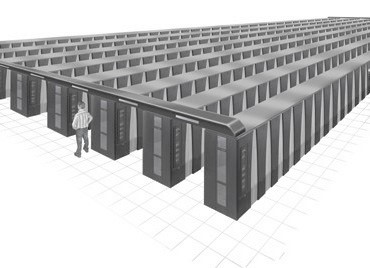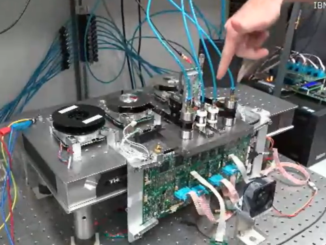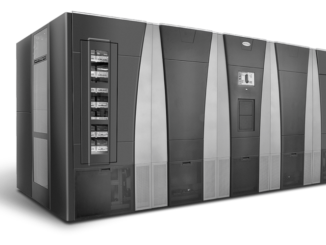
IPOs and major investments in storage startups are one thing, but when it comes to a safe tech company investment, all bets are still on tape.
The rumors of tape’s death are greatly exaggerated, but there have been some changes to the market. While the number of installed sites might be shrinking for long-time tape storage maker, SpectraLogic, the installation sizes of its remaining customers keeps growing, which produces a nice uptick in revenue for the company, according to its CTO, Matt Starr.
This makes sense since the relatively smaller backups and archives make better performance sense on disk—and many smaller ex-tape customers have gone this route. But for the truly large-scale sites with large, cold store archives, tape is, as much as one can say for any storage media, forever.
Privately-held SpectraLogic has been around since 1979 and its founder is still at the helm almost forty years later. They weathered strong competition when tape was at the pinnacle of large-scale data storage in the early years, but these days, the competitive ecosystem has shifted dramatically. This became clearer this week w
When its major competitor, StorageTech, another long-running company that shifted hands a few times following an acquisition by Sun, announced it would be shuttering its efforts on new tape offerings. While this still leaves IBM and Quantum as challengers, Starr says their emphasis on the largest-scale tape installs will keep them pushing past their competition for years to come. The exit of a major competitor bodes well for them—and he says does not necessarily indicate that the death knell is sounding for tape.
When it comes to storage businesses in trouble, Starr says the disk makers have far more to worry about in the near term. “They have the largest technology innovation wall in front of them. Flash is also squeezing them out so a lot of their profitable high-end 15k drives have gone to flash; all of mobile is gone; and now they’re stuck in a 7200 RPM high capacity world. Disk is the least profitable per unit, so they have the toughest of the different storage technologies on the horizon.” In short, the margins are near-zero, as they are getting to be across the wider world of hardware.
This brings up an interesting point. If storage device makers are facing slim margins, what do the margins look like in tape (which has major manufacturing costs of its own given the complex robots required to pull archives along with the software stack R&D).
“The margins for tape have various aspects. Unlike a disk subsystem (rack or chassis drive controllers) the difference with a tape library, it will stay in the field for between 12-20 years. There’s a T950 at NASA Goddard, it shipped in 2003, it’s being upgrade over those years and still have prior generation libraries 20 years old still in production. When we look at the lifetime of an archive—the support and upgrade revenue—I don’t need a huge lump sum on the front end. Our customers are long-term. Once the tape chassis is on the floor, there will be upgrades and support renewal and this continues,” Starr explains. “Tape, unlike disk where they’re selling a new disk system every 3-5 years gets pretty cutthroat. The cheapest often wins. Disk has too many people fighting for a single customer.”
If the margins are good and the business is strong, why aren’t there more competitors in tape? As noted earlier, many smaller installations have moved to disk, but when it comes to large-scale tape libraries for big centers, one might think there’s an opportunity that cannot be tapped by the very few companies in the tape game.
“It’s a good question why there aren’t more competitors here,” Starr says. “From an investment perspective though, tape is not sexy. The analogy is locomotives. Warren Buffett bought into railroad stocks a few years ago because they were never going away; it’s the long game. That’s tape. It is the locomotive of data storage. It holds the most the longest and at the lowest cost. And yes, it has a penalty—it’s slower.” It’s about picking the right tech for the right time though; it needs to be balanced between disk, flash, and tape. But most of your data isn’t being touched anymore, so it doesn’t need to be on disk.
“It is getting to the point where customers actually believe they can keep everything forever,” Starr says. And that is a problem—for the user, at least.
Slow and steady is the word with tape, but for the largest national labs and other institutions that are inclined (or better, required) to save everything, there is simply no cost-effective replacement for tape. Starr could not tell us whether SpectraLogic would be providing the tape backend for the large CORAL supercomputers or other big forthcoming systems, but it is unlikely that a center would look to another option for its cold storage.
On the other side of the large-scale storage user base—cloud and hyperscale web companies—tape is still strong as cold storage. Even with the delay to get data off tape (around two minutes), this presents the only reliable and cost-effective option, well under cost compared to even the cheapest disk, and even after considering the post-tape drive and retrieval system costs (maintenance, etc). “In cloud, if a customer is not using tape to store cold data, competitors are,” Starr says, noting that Spectra is well-acquainted with Google, among others.
Still, he tells The Next Platform that the storage stack is indeed changing in HPC in particular and similar shifts could make their way to the hyperscalers in the near term as well. “We are seeing the shift with people in HPC producing things like MarFS and object storage approaches and with burst buffers. Really, the whole workflow around storage is changing. We will start seeing an archive made of a parallel file system with all data stored there and we’re there, moving it in and out of a scratch file system. A lot of people today overuse their scratch file system; it’s being used for home directories and other non-HPC work where files are just parked.”
Starr says a time is coming when that file system is going to be more expensive and will be locked down and this presents an opportunity for tape. “People are running tens of thousands of core jobs with snapshots of their memory—some people are even keeping every memory snapshot, which is really kind of shocking.” What is needed, of course is a more balanced storage arrangement that can shuttle the truly cold stuff off to tape and balance the rest based on expense versus immediate need. But there’s an unexpected issue with that.
No matter what changes, Spectra’s longest-running customers will stick around. The key to keep new supercomputing and cloud sites interested enough by cheap, reliable capacity. Starr expects this won’t be a problem—and with at least one competitor out of range, they will keep pursuing the largest-scale installations in HPC, enterprise, and hyperscale.
The company has produced a report on the state of storage (with an obvious tape emphasis) available here. It provides some outlook on the future of other storage media as well.




Be the first to comment